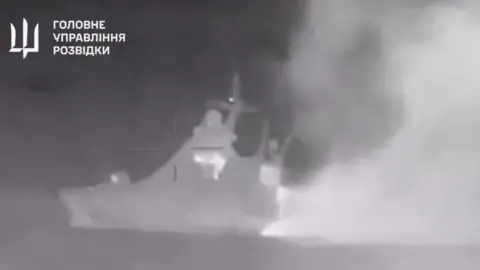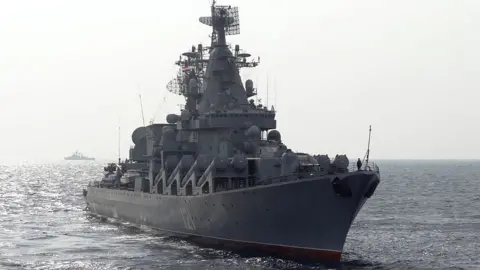Abdujalil Abdurasulov

It was a dark night when the attack happened. Ukrainian drones were approaching fast through the water.
By the time the crew of the Russian patrol ship Sergey Kotov saw them, it was too late. Russian sailors opened fire with heavy machine guns, but their ship was hit and destroyed.
Ukrainian sea drones have revolutionised naval warfare over the last few years, relentlessly hunting down Russian ships in the open sea and even at naval bases.
Group-13, a secretive unit of Ukraine's military intelligence agency, was behind the Sergey Kotov attack last week, and the BBC has been given rare access to its operations.
Since it was set up last year, the unit says it has sunk five Russian vessels and damaged others. But its commander, who asked us to refer to him by his call sign, Thirteenth, says the Sergey Kotov was the most difficult target so far.
Group-13 had attacked and damaged the ship twice in the past, but only managed to sink it on the third attempt.

Ministry Of Defence Of UkraineFootage released by Ukraine purported to show the Sergey Kotov being sunk by drones.
Commander Thirteenth took us to a peaceful-looking corner of Ukraine's Black Sea coast to show us one of the unit's naval drones in operation.
The Magura V5, named after a Slavic goddess of war, looks like a small motorboat with a flat surface instead of passenger seats.
"It doesn't emit a lot of heat, so it's almost invisible for thermal cameras. It's made from plastic, therefore even radars struggle to see it," says Thirteenth.
Produced by the Ukrainian armed forces, the drone's claimed range is 800km (500 miles), so it can easily reach the Crimean peninsula and even the Russian coastline. It can allegedly carry 250kg of payload, enough to sink a warship.
The boat's remote control looks like one of those specially adapted nuclear briefcases, used by world leaders in Hollywood films to authorise the use of nuclear weapons. There is even a red toggle switch for "manual detonation", explains Thirteenth.
The drone is controlled from base via a satellite link. "You can control if from any part of the world if you have internet," says Thirteenth. The Magura V5 has back-up connections in case the main one fails, he adds.

The drones are hard to spot because of their speed and size, says Commander Thirteenth
He admits that Russian electronic warfare systems can jam the signal, but he claims the drones are able to overcome it. Unsurprisingly, he did not want to elaborate how.
When a Magura drone is targeting a Russian ship, it can allegedly sail up to 80km/h (50mph). Thanks to its speed and size - 6m (20ft) long - it's hard to spot, especially among the waves at night.
Last week the crew of Sergey Kotov found that out the hard way.
Dodging bullets
Soldiers on Russian ships try to destroy approaching drones with heavy machine guns. But it's hard to hit them as they are so small and manoeuvrable.
The use of special tracer ammunition, which lights up when discharged, helps Russian soldiers to direct their fire at night. However, those rounds also help Ukrainian drone operators dodge bullets.
"They show us where the fire is coming from, where they hit and which direction we should take to manoeuvre," says Thirteenth.
Judging by footage of past attacks, several drones are usually involved in a single attack in order to increase the chances of hitting the target.
Operations to hunt down a warship can last for days. Operators must stay focused the entire time. "After finishing my work, I'm as exhausted as a squeezed lemon," Thirteenth quips.
Ukraine's military intelligence agency, HUR, does not disclose the cost of its drones. However, Thirteenth clams that the Russian missile boat Ivanovets, which was destroyed by Group-13 last month, would have cost Russia more than all drones produced by HUR since the beginning of 2023.
Making the Russian fleet vulnerable
Ukraine's success with naval drones in this war dates back to the 2022 attack on the flagship Admiral Makarov. That operation was conducted by the SBU, Ukraine's secret service, which also produces its own Sea Baby and Mamay drones.
It also carried out drone attacks last year on the Kerch Bridge, which connects occupied Crimea and Russia, and the Port of Novorossiysk in Russia.
Following Moscow's annexation of Crimea in 2014, Ukraine lost almost its entire naval fleet. Its only remaining frigate, the Hetman Sahaidachny, was scuttled just a few days after the full-scale invasion in February 2022.

Ukraine's success with naval drones dates back to the 2022 attack on the flagship Admiral Makarov, which was badly damaged
Ukraine has nevertheless managed to resist Russia's attempts to dominate in the Black Sea.
In 2022 Ukraine sank the Russian flagship Moskva with the help of homemade Neptune missiles. They also hit a submarine and the Russian Navy's headquarters in Sevastopol, reportedly with long-range Storm Shadow missiles.
Russia has lost five of an estimated 13 amphibious landing ships in the Black Sea. Two of its four smaller patrol warships have been destroyed or damaged.
It is, however, naval drones that have made Russia's Black Sea fleet particularly vulnerable. Under relentless attacks, Moscow was forced to withdraw the core of its fleet from Crimea and move them further east, to Novorossiysk. And even there, Russian ships remain within reach of Ukrainian drones.
As a result, Russian vessels stay away from the Ukrainian shore and limit their time in the open sea. They now launch Kalibr cruise missiles from ships in the Black Sea much less frequently, says Dmytro Pletenchuk, the Ukrainian Navy's spokesman.
The last confirmed launch was in mid-February and "prior to that, there had been no cruise missile launches from the sea for several months", he says.
It is believed there are 10 Russian cruise missile carriers, including three submarines, remaining in the Black Sea. Almost all of them are now stationed in Novorossiysk.
No comments:
Post a Comment